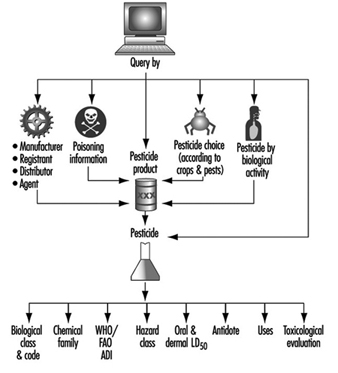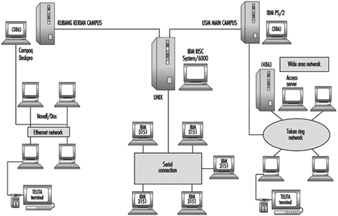Introduction
Unlike problems that command the attention of the industrialized countries with respect to pesticide hazards, namely, chronic occupational exposure and environmental contamination, the major threat posed by pesticides in many developing countries is acute poisoning itself. A recent estimate by the World Health Organization (WHO) puts the annual number of severe poisonings at 3 million, with about 220,000 deaths. It is a matter of further concern that, based on a survey of self-reported minor poisoning in four Asian countries, it was shown that each year 25 million agricultural workers in the developing countries are exposed to the danger of acute pesticide poisoning (Jeyaratnam 1990).
In Malaysia, a largely agricultural country, the use of pesticides is relatively prevalent. In Peninsular Malaysia alone, about 1.5 million hectares of land are devoted to the cultivation of rubber trees and 0.6 million hectares to oil palm trees. The employment of almost 4.3 million people is related to agriculture.
The principal legislation for the control of pesticides in Malaysia is the Pesticides Act of 1974. The main intent of this Act is the control of the manufacture and import of pesticides through registration. Other aspects of control include the licensing of premises selling pesticides and storing them for sale, the proper labelling of pesticides, and control of the import of unregistered pesticides for research and educational purposes (Tan et al. 1992).
Surveys carried out by the local agrochemical industry showed that in 1987, most of the estimated 715,000 rubber and oil palm smallholder farmers used paraquat (Shariff 1993). Over a ten-year period (1979–1988), pesticides accounted for 40.3% of the total number of 5,152 cases of human poisoning in Malaysia. Paraquat contributed 27.8%, other weed-killers 1.7%, malathion 4.7%, other organophosphates 2.1%, organochlorine compounds 2.6%, and other pesticides 1.4%. Annually, 230 million ringgit (MYR) is spent on weed-killers alone (Tara et al. 1989). It has been estimated that about 73% of poisonings involving paraquat are suicidal, compared with 14% due to accidents and 1% due to occupational exposure (Jeyaratnam 1990).
Poisoning cases due to pesticides have not been well documented. However, such incidents do occur, according to a number of selected studies. A survey showed that poisoning had occurred in 14.5% of the 4,531 farmers growing vegetables, flowers and fruits in the Cameron Highlands. Hospital admissions showed 32.1% were accidental pesticide poisoning and 67.9% suicidal cases. In Tanjung Karang, a paddy growing area, 72% of rice farmers experienced poisoning symptoms when handling pesticides, and proper clothing, goggles, shoes and respiratory masks were seldom worn. In 1989, 448 pesticide workers received medical treatment at government hospitals (Lee 1991).
In another study (Awang et al. 1991) conducted in a predominantly agricultural area, it was reported that 12.2% out of a total of 264 poisoning cases treated in a teaching hospital were due to pesticides. In yet another study (Majid et al. 1991) serum pseudocholinesterase levels, which were used as an indicator of exposure to the organophosphates, were found to be significantly lower in vegetable farmers: the degree of decrease in these blood levels is dependent upon the length of exposure to these pesticides.
The use of pesticides in Malaysia has caused serious concern. A recent report by the Malaysian Factories and Machinery Department, an agency that enforces the Occupational Safety and Health Act, revealed that the accident rate for improper handling of pesticides is four times higher than that of other industries, and is as high as 93 per 1,000 workers as compared with the national average of 23 per 1,000 (Rengam 1991). This seems to indicate that there is an insufficiency of educational materials and information on safety and an apparent lack of caution in the handling of pesticides. A 1994 report also highlighted the death of about 70 cattle, suspected to be due to paraquat poisoning as a consequence of the animals’ re-entry into a sprayed area (New Straits Times 1994).
Clearly there is an urgent need not only to collect data but also to facilitate education among those involved in the use of pesticides. It is with this in mind that a pesticide information service was developed and a pilot information system was launched throughout the country in 1989. It is part of the Integrated Drug and Poison Information Service (IDPIS) of the National Poison Centre based at the Universiti Sains Malaysia (USM) at Penang.
The primary aim of the IDPIS is to disseminate information concerning health-related matters, especially with regard to drug usage and poison control, to health professionals and the public alike (Razak et al. 1991).
The pesticide information service, which was launched through the videotex system, has had the welcome side-effect of opening up new possibilities for several other databases important for health care. IDPIS databases were continually being used as a guide for the development of other databases for the management of information relating to pesticides, industrial and household chemicals and food supplements. The Pestinfo system was one such product; it was initiated by IDPIS in collaboration with the Pesticide Board (the Malaysian pesticide regulatory body) and the Malaysian-German Pesticide Project. This arrangement has been conspicuously successful in terms of information validation and the evaluation of information needs in view of countrywide trends in pesticide use.
This system is focused on registered pesticides in Malaysia, but could also cater to those found throughout the Asia-Pacific region. To date, information on more that 500 biochemically active substances has been incorporated into the pesticide information system, with some 3,000 commercially available products and their profiles listed. The system is available in two modes, namely, via a videotex system and also through a computer network utilizing PCs. The former facility is called Pestinfo, while the latter is called the Pesticide Information System (see figure 1).
Figure 1. Information flow and relational access in the Pesticide Information System
Pestinfo
The Pestinfo system is the first to be made available in this region and operates via TELITA, Malaysia’s National Videotex System. Operated by Malaysia’s Telecommunication Company, TELITA provides nationwide access that is both cheap and fast. TELITA can be accessed through a television set and a decoder or a computer system equipped with a modem connected to a telephone network (Siraj 1990). Such a system is economical as each dial-up costs only MYR 0.13 (less than US$ 0.05) and access time is charged at only MYR 0.08 a minute. It is internationally unique in its approach in that it is both professional- and community-based. Information in Pestinfo is collectively packaged with two other closely interrelated on-line databases (called Drugline and Poisonline) to maximize the relational information provided to the end-user.
Pestinfo can be accessed by members of the public and by professionals alike, including those in the agricultural sectors, whether extension workers or field workers. All the databases are well integrated, and yet independent, so that all pertinent data can be easily accessed. For this reason, the USM’s Pestinfo is sequentially arranged into at least 15 subcategories.
End-users who are health care providers are also able to gain direct access to Poisonline, which carries further specialized details with regard to patient management in cases of poisoning.
Poisonline by itself is in fact a broad-base information module covering several classes of poisons, including pharmaceuticals, as well as industrial and household chemicals, food and cosmetics. It provides information on poisoning signs and symptoms according to anatomical systems, on treatment and management modalities, and on aspects of poisoning prevention. Also included are detailed antidote information and emergency treatment procedures.
The on-line Poisoning Reporting System is an outstanding feature incorporated in Pestinfo, and in Poisonline as well. This feature enables first-line reporting to be done electronically by the end-user, through a specially designed format, when any case of poisoning is encountered. It not only allows automatic documentation of all the cases reported, but simultaneously acts as an instant referral system which permits follow-up to be done systematically. Through the reporting system too, initiation of the appropriate immediate response can be undertaken to further assist the user in the management of the poisoning case. Data obtained via the Poisoning Reporting System will automatically be stored in a PC-based network system to make it possible to generate statistical reports.
Additionally, all users of Pestinfo will be able to access several other user-friendly databases on public education with emphasis on health, especially in pharmaceutical-related areas. These databases aim to educate the public on proper chemical and drug use and the maintenance of good health. The main database designed for this purpose is designated Public Infoline.
An attractive feature with regard to public education is the “Ask Your Pharmacist” service, which provides an electronic mail service for questions and answers concerning any topics relating to health. This is available free to all users.
The Pesticide Information System
The initial experience with Pestinfo has led to the development of the Pesticide Information System, which offers new possibilities of information processing for purposes of identification in cases of poisoning and can serve as a medium of reference for extension workers as well as a means of compiling poisoning events that could be of assistance in policy decision-making and planning for health centres. Because the videotex system was not fully equipped to meet these needs, an application that provides several flexible search functions was developed using the PC.
As mentioned earlier, the pesticide information service is complemented by a user-friendly network-based microcomputer system that runs on IBM-compatible PCs. This application is called the Pesticide Information System Version 2.3 and has been specially designed for maintenance of up-to-date documentation as well as for the processing of poisoning records received electronically or otherwise. It can be instructed to produce baseline statistical reports as well as to respond to other data manipulation requests as stipulated in the software. It is thus more flexible in retrieving information, given the added processing and interactive powers accorded to it by each PC. It was designed using dBase3 Plus and compiled under Clipper Summer 5.0.
The Pesticide Information System contains additional relevant information which can be readily accessed either by pesticide name, composition, registration number and name of the manufacturer or registrant of each and every product registered in the country. The main menu of the System is described in figure 1. The System is particularly suitable for use by health professionals as well as by agriculture-based personnel since it can be loaded on a portable computer.
To date, more than 50% of the poisoning cases received on-line have been pesticide-related (Latiff et al. 1991). The combination of the two modes of operation described above has undoubtedly enhanced the running of the Pesticide Information System, making possible an even faster response to a broader range of inquiries.
Future Directions
The task of compiling and disseminating pesticide information to users has been very successful even though it has been carried out on an informal basis. IDPIS has also taken new directions in the light of the rapid progress in hardware and communication technology. For instance, network-based applications will also be linked up to users nationwide through a collaboration with a network communications company that supports and provides communication link-ups for the whole country. This will further enhance the communicability of health information, as this sort of arrangement ensures economical solutions to both the user and to IDPIS as the information provider.
Currently, IDPIS operates on two networks, namely Token Ring and Ethernet, for the purpose of research and development work in information systems (figure 2). The former is installed at the University Teaching Hospital. Both networks are connected to an IBM RISC6000 so that information and resources within the servers of the two networks can be shared and coordinated to provide facilities for education, training and research. The networks will be designed to incorporate a tool for surveillance in the areas of pharmacoepidemiology and toxicovigilance.
Figure 2. The network-based Integrated Drug & Poison Information System (IDPIS)
In 1996 IDPIS set up its own Homepage on the Internet as the Malaysian Drug and Poison Net, at http://prn.usm.my.


